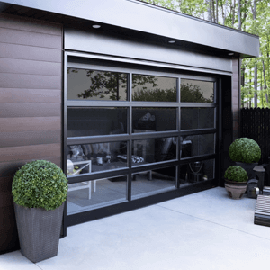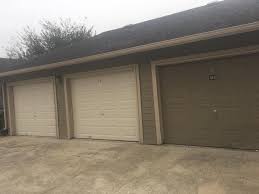
For homeowners looking for a quiet, sleek design, a belt drive garage door opener is the right choice. They can be fitted on doors up 7 feet high and come with multi-functional wall controls and safety sensors.
The belt runs along a track which is connected to a trolley. This drives the door open/close. This system is very quiet and rarely requires lubrication.
This opener can be used on single and double residential garage doors. But, they can also attach to heavier commercial doors like steel rolling doors or wood-insulated doors. Raynor dealers will be able to help you select the right model.
Chain-driven garage door openers are generally more load-bearing than belt drives. They can also be used on heavier and larger doors. They can also be more robust and may last for longer periods of time in certain applications.

They're also a bit cheaper than belts, although this may depend on the frequency of use and other factors. They can still cost more than a belt, but they're an excellent option for people who want a good garage door opener without paying extra.
A chain is made from metal or polyurethane. It is attached to a drive trolley with a threaded link. This opener is more durable than the belt, but can make it noisy when opened manually. The chain can be lubricated to reduce friction and noise.
If the chain is damaged or worn, it can be replaced. However, they aren't as easy to replace as a belt is and it may be more expensive.
Chains have a downside: they can be noisy when the door is being opened or closed. This is especially true if the opener is located near the house, detached garage, or other nearby structures. A battery backup opener may be an option if this is the situation.
If there is excessive noise from the opener, call a professional to have it checked. This could indicate a more serious problem, such as a damaged track or warped rolling.

Depending on your garage door brand, the source of the beeping may vary. It might be the remote, keypad, sensors, or even a fuse or circuit breaker.
You can install a battery backup on some models if you have an accessible electrical outlet from your garage. This will keep the opener operational if power goes out in your area and will allow you to use it when your main house power is restored.
Most modern models have DC motors and soft start and stop capabilities, which can also help reduce noise. They offer a long warranty and are very reliable. You will also save money in long-term maintenance costs because they do not require lubrication like chains or screws.
FAQ
What order should you renovate your house?
First, the roof. The plumbing follows. Third, the electrical wiring. Fourth, walls. Fifth, the floors. Sixth, are the windows. Seventh, the door. Eighth is the kitchen. Ninth, the bathroom. Tenth is the garage.
After all the above, you are now ready for the attic.
If you don't know how to renovate your own house, you might hire somebody who does. It takes patience, time, and effort to renovate your own home. It can also be expensive. If you don't have the time or money to do all the work, why not hire someone else?
While renovations can be costly, they can help you save a lot of money over the long-term. A beautiful home can make your life easier.
How much would it cost to gut a home vs. how much it cost to build a new one?
The process of gutting a house involves removing all contents inside the building. This includes walls, floors and ceilings, plumbing, electrical wiring and appliances. It's often necessary when you're moving to a new house and want to make changes before you move in. It is often very costly to gut a home because of all the work involved. Depending on the job, the average cost of gutting a home is between $10,000 and $20,000
Building a home means that a builder constructs a house piece by piece, then adds windows, doors, cabinets and countertops to it. This usually happens after you have purchased lots of lands. It is usually cheaper than gutting a house and will cost around $15,000 to $30,000.
When it comes down to it, it depends on what you want to do with the space. You'll need to spend more if you plan to gut your home. If you're building your home, however, you don't have to tear everything down and start over. You can design it yourself, rather than waiting for someone else.
What are the included features in a full remodel of your kitchen?
A complete kitchen remodel involves more than just replacing a sink and faucet. There are also cabinets, countertops, appliances, lighting fixtures, flooring, plumbing fixtures, and much more.
A complete kitchen remodel allows homeowners the opportunity to upgrade their kitchens without any major construction. This means there is no need to tear down the kitchen, making the project more manageable for both the homeowner as well as the contractor.
Kitchen renovations include various services, including electrical, plumbing, HVAC, carpentry, painting, and drywall installation. A complete kitchen remodeling project may require multiple contractors depending on the size of the job.
Professionals with years of experience working together are the best way ensure a successful kitchen remodel. Kitchen remodels are complex and can be delayed by small issues. You should plan ahead and prepare a backup plan for any unexpected situations if you decide to DIY.
How much is it to renovate and gut a whole kitchen?
It's possible to wonder how much a home remodel would cost if you are thinking of starting one.
A kitchen remodel will cost you between $10,000 and $15,000. There are many ways to save money and improve the overall feel of your kitchen.
You can cut down on costs by planning ahead. This includes choosing a style and color scheme that suits your lifestyle and finances.
Another way to cut costs is to make sure that you hire an experienced contractor. A tradesman who is experienced in the field will be able to guide you through each stage of the process.
It's a good idea to evaluate whether your existing appliances should be replaced or preserved. The cost of replacing appliances can increase by thousands of dollars in a kitchen remodel project.
In addition, you might decide to buy used appliances instead of new ones. Because you don't need to pay for installation, buying used appliances can help you save some money.
Shopping around for fixtures and materials can help you save money. Many stores offer discounts for special occasions like Cyber Monday or Black Friday.
What does it cost to tile a shower?
Do it yourself if possible. It's an investment to remodel a full bathroom. When you consider the long-term benefit of having a beautiful space for many years, it is a smart decision to invest in quality fixtures and materials.
You can make a big impact on how your room looks. We have a guide that will help you pick the best tiles for your room, whether you are planning a minor or major renovation.
First, decide which type of flooring you'd like to install. You have many choices: ceramics, natural wood, stone, porcelain and even stone. Next, pick a style like classic subway tiles or geometric designs. Choose a color combination.
For large bathroom remodels, you will likely want the tiles to match the rest of your room. For example, you may opt for white subway tile in the kitchen and bath area while choosing darker colors in other rooms.
Next, consider the size of your project. Is it time for a small update to the powder room? Or, would you rather have a walkin closet in your master bedroom?
Once you have determined the scope of your project, go to local shops and look at samples. This allows you to get a feel and idea for the product as well as its installation.
You can also shop online to find great deals on porcelain and ceramic tiles. Many sellers offer discounts and free shipping for bulk orders.
Why remodel my house when I could buy a new home?
While houses may get more affordable each year, the square footage you pay is still the same. Even though you may get a lot of bang for your buck, you also pay a lot for that extra square footage.
It costs less to keep up a house that doesn't require much maintenance.
You can save thousands by remodeling your existing home rather than buying a completely new one.
By remodeling your current home, you can create a unique space that suits your lifestyle. Your home can be made more comfortable for your family.
Statistics
- Attic or basement 10 – 15% (rocketmortgage.com)
- 57%Low-end average cost: $26,214Additional home value: $18,927Return on investment: (rocketmortgage.com)
- bathroom5%Siding3 – 5%Windows3 – 4%Patio or backyard2 – (rocketmortgage.com)
- 55%Universal average cost: $38,813Additional home value: $22,475Return on investment: 58%Mid-range average cost: $24,424Additional home value: $14,671Return on investment: (rocketmortgage.com)
- Following the effects of COVID-19, homeowners spent 48% less on their renovation costs than before the pandemic 1 2 (rocketmortgage.com)
External Links
How To
How to Remove Tile Grout on Floor Tiles
Most people don’t realize they use tile grouting. It is used to seal joints between tiles. There are many types available today. Each is used for a specific purpose. We will demonstrate how to remove grout from tile floors.
-
Before you can begin the process, ensure that you have all necessary tools. You will need a grout cutter and grout scraper.
-
You will now need to clean off any dirt and debris that may have been under the tile. Use the grout cutter to cut away at the grout and gently scrape away any loose pieces. You must be careful not to scratch any tiles.
-
After everything is cleaned up, use the grout scraper for any remaining grout. If there isn't any grout left, you can go to step 4.
-
After all the cleaning is done, it's time to move on. One of the rags can be used to soak in water. You want to make sure that the rag gets completely wet. Make sure the rag is completely dry after it has gotten wet.
-
Place the wet rag onto the joint where the tile meets the wall. The grout will begin to crumble if you press down hard on the rag. Slowly pull the rug towards you, then continue pulling the rag back and forth until the grout has been removed.
-
Repeat steps 4 to 5 until grout is gone. Rinse the ragout and repeat the process if necessary.
-
After you have removed grout, dry the tiles by wiping them with a damp cloth. Let dry thoroughly.